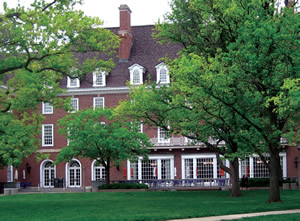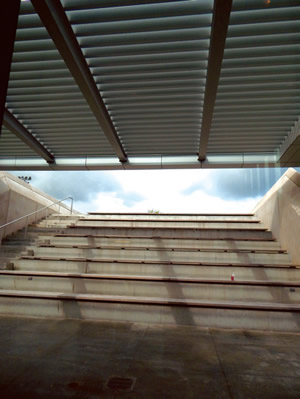Outside the Walls

PHOTOS © SCOTT BERMAN
Attractive, distinctive and impactful hardscapes and outdoor seating areas are where you find them. They appear in a wide variety of places, busy and quiet, at the center and periphery of a college or university campus. High and low, too.
For example, there is a plaza in an area excavated out from grade to create a sunken but sunny exterior to complement interior space at the School of Business at the University of Albany SUNY. There is concrete step seating on the roof of San Francisco State University’s Cesar Chavez Student Center, where that distinctive configuration looks out over the grounds and is a frequent locale for programmed and informal uses. Indiana State University in Terre Haute is renovating its bustling DeDe Plaza, a concrete area with a subtle amphitheater effect that serves as an important campus crossroads.
Elsewhere, a new green roof terrace with benches creates a spatial moment, if you will, to pause amid the bustle of Pennsylvania State University’s newly expanded student center. The exterior spot, raised as it is to the terrace level of the building and reached through a curtain wall, seems to gently blur the boundary between inside and outside, and the transition is softened even more by a sequence of interior carpet tile to curtain wall to a thin ribbon of exterior gravel in complementary colors.

PHOTOS © SCOTT BERMAN
Consider the Hardscape
Reconfiguring or creating new concrete features can make major differences to prime campus locations. In Macon, GA, Mercer University’s Cruz Plaza, a flowing plan of paths and planters amid expansive green areas and brickwork, recently remade the center of that campus. California State University–Northridge, several years after an earthquake hit its campus, removed a section of the low wall of a concrete terrace in front of its Oviatt Library, opening up a space to create a broad set of steps to a central lawn below, creating a more dramatic setting and new vistas.
Exterior elements of a more modest scale can also make a distinctive difference. There is an interesting set of concrete steps outside Case Western Reserve University’s new university center in Cleveland, OH. The steps are a place to pause, socialize, eat lunch and watch movies — the steps face an overhang from which a screen is hung as needed for that purpose. Elsewhere, the main quad at the University of Illinois, Urbana-Champaign, where a concrete deck behind a balustrade is equipped with patio chairs and tables, is a well-used gathering spot in a prime, heavily trafficked location. There’s also a simple spot with benches beneath a grand shade tree on the campus of Bradley University in Peoria, IL — a notable touch in that a recent addition to a nearby building is curved to preserve and acknowledge the tree and its zone of shade.
If They’re Used, They’re Working
That being said, location and aesthetics are crucial, but the success of exterior spaces can be assessed in large part by how well and frequently they are used. Indeed, what’s happening in such spaces is crucial. In one case, Harvard University’s Common Spaces initiative, a committee came together to map out approaches to provide exterior campus spaces, equip them with tables and chairs, and program plenty of activities to “foster a strong sense of community,” according to the institution’s website.

PHOTOS © SCOTT BERMAN
More broadly speaking, the design and uses of exterior spaces on a campus depend on things that range from budget to climate, explains Duke University Landscape Architect Mark Hough, as well as outdoor furniture.
Hough notes that while local traditions certainly factor in to the styles of furniture, those traditions are tempered a general movement toward an urban look and feel. On another point, he suggests that furniture and seating areas be placed where there is natural or constructed shade, such as that provided by building overhangs, where such areas can be “part of the building’s expression.” On yet another furniture matter, Hough points to flexible, moveable pieces that dot the grounds of his Durham, NC, campus, explaining that enabling users to rearrange pieces, primarily metal tables — square ones so they can be easily combined — and chairs, helps to make and keep such spots lively.

PHOTOS © SCOTT BERMAN
Victor Stanley’s Emma Skalka sees interest today in distinctive yet affordable outdoor furniture, such as “curved and zigzag benches.” Among the other aspects generating buzz: “unusual colors.”
How Well is It Made?
Whatever the product, it’s important to bear some things in mind, notes Skalka, including durability. She suggests, among other things, asking for customer references keyed to how long you expect the product to last; and if the product is metal, for details about the product’s powder coating, which prevents rust. Get a sample and see how the product looks and feels on your campus, Skalka adds, and take a close look at any moving parts on a product, which “tend to be a weak point in the structure, so it needs to be supported very well.”
Another aspect to consider is the use of recycled materials. Plastic, steel and wood furnishings often include recycled and reused content, and touting the sustainability of your exterior furnishings is a positive message that resonates with students, as well as faculty and staff. Installing furnishings made with recycled materials can also contribute to LEED certification.
“The key is consistency,” says Angela Mahoney, director of marketing for Keystone Ridge Designs. “Consistent colors, materials and product designs across campus contribute to a cohesive campus design and help to distinguish campus property.” Mahoney explains, for example, that litter receptacles keep things tidy; bike racks “encourage alternative transportation and define bicycle parking areas,” recycling containers and ash receptacles encourage practices and define spaces on a campus; and “table sets and benches create public spaces for students to relax, meet and gather.”

PHOTOS © SCOTT BERMAN
WHERE THE SIDEWALK ENDS. The features that exist outside your campus walls matter. Students and visitors will notice everything from parking lots to plantings, pathways, sidewalks, stairs and all the other components of your landscape and hardscapes. First — and lasting — impressions of open-air components of your campus can become an important marketing tool, so include them in your master planning efforts.
Those needs and desirable outcomes for exteriors remain, but with some things changing. “The biggest trend we are seeing is in site furniture customization,” Mahoney says, such as in “custom colors to match school branding, custom logos and school crests incorporated into furniture with laser cutting and decals to further enhance the school’s identity.” The move infuses exterior areas with the school brand and recognizes the institution’s culture widely.
As Mahoney says, “These products are being used everywhere across campuses, such as in courtyards, patios, along walkways, at building entrances and more.” Mahoney also notes the option of “custom plaques added to benches” and other outdoor features “to honor and memorialize donors and alumni.”
Furniture to Inform
That last point, utilizing outdoor features to recognize members of the university community, underscores and expresses important relationships. Plaques, either freestanding or affixed to outdoor furniture or other objects, can be thought of as opportunities to do multiple duties. They can serve as teaching moments, as they do at Illinois State University in Normal, IL, not only about campus achievers and activists, but also about history, campus culture, the environment and horticulture, such as detailed signage placed amid greenery and landscape features.
It’s essentially about creating the best possible outdoor setting for campus life and work. And whatever precise forms their designs take, distinctive, impactful outdoor areas are, indeed, wherever you find them.
About the Author
Scott Berman is a freelance writer with experience in educational topics.